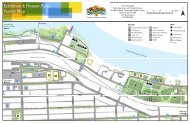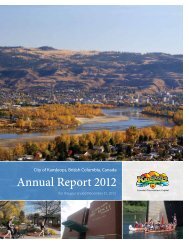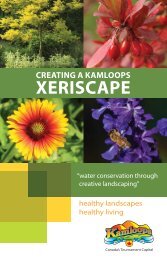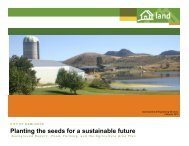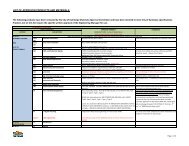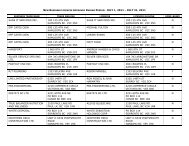Gardening for Pollinators - City of Kamloops
Gardening for Pollinators - City of Kamloops
Gardening for Pollinators - City of Kamloops
You also want an ePaper? Increase the reach of your titles
YUMPU automatically turns print PDFs into web optimized ePapers that Google loves.
Planting <strong>for</strong> pollinatorsAttract bees by:• Choosing open flowerswith packed clusters <strong>of</strong> tinyflowers,• Planting blue, purple, whiteand yellow flowers.Attract pollinating flies such aslacewings & syrphid flies by:• Choosing open flowerswith packed clusters <strong>of</strong> tinyflowers,• Planting white and yellowflowers.Attract butterflies & day flyingmoths by:• Choosing open or deeperflowers to accommodatetheir feeding habits,• Choosing plants that aresuited as hosts <strong>for</strong> theircaterpillar stage,• Planting blue, violet, andred flowers.<strong>Gardening</strong> <strong>for</strong>pollinatorsWhat are pollinators? They are insects that transferpollen from plant to plant. Pollination is essential <strong>for</strong>fruit and seed production. <strong>Pollinators</strong> include avariety <strong>of</strong> bees, both native (such as bumble bees,mason, leafcutter and sweat bees) and non-nativehoney bees, as well as flies, moths, butterflies, andsome beetles.A note about native bees: There are well over 400species <strong>of</strong> native bees in BC. Native bees are mostlysolitary. They don’t <strong>for</strong>m hives. Bumblebees <strong>for</strong>msmall nests, but over 70% <strong>of</strong> native bees spend most<strong>of</strong> their lives underground in tunnels. Other nativebees live in cavities <strong>of</strong> dead wood or pithy stems.Unlike honey bees, native bees collect mostly pollenand do not produce surplus honey. Except <strong>for</strong>bumble bees, native bees don’t sting. They have ashort life span (<strong>of</strong>ten only 2-3 weeks) and have ashort <strong>for</strong>aging range <strong>of</strong> only 100 – 200 metres fromtheir nesting sites. Honey bees are not native toCanada.Threats to pollinators: Urban sprawl, industrialagriculture and landscaping practices lead to habitatloss and loss <strong>of</strong> plants used by pollinators <strong>for</strong> <strong>for</strong>age.Pesticide use kills beneficial insects as well astargeted insects. Honey bees are threatened byprotozoa and mites.• Native flowers, abundant in nectar and pollen.Exotics, especially double flowers and newcultivars tend to have less nectar and pollen.• Heirloom varieties that are rich in nectar andpollen,• Clumps or swaths <strong>of</strong> each flower species thatattract the attention <strong>of</strong> pollinators,• Shrubs and trees such as apple, dogwood, andnative willow (avoid weeping willow) that providepollen and nectar in the spring.Enhance pollinator habitat by:• Offering water to pollinators in a shallow dish orbirdbath,• Providing a muddy spot that supplies nutrientsto butterflies and nesting materials <strong>for</strong> some bees,• Allowing a corner <strong>of</strong> your yard to go wild withgrasses, weeds, wildflowers, logs and brush thatprovides food, nesting sites, shelter and overwinteringsites,• Leaving areas in your yard mulch free <strong>for</strong> groundnesting bees,• Allowing leaf litter to remain in your garden asover-wintering sites <strong>for</strong> bumble bees.Design: Mader & Assoc.Attract night flying moths by:• Choosing deep and openflowers with a strong, sweetscent,• Planting white, cream orpale green flowers that arevisible at night.Attract pollinating beetles by:• Choosing wide open bowlshaped flowers.Specific suggestions areprovided in a chart on the nextpage.Supporting bees andbeneficial insects...why should we care?The work <strong>of</strong> pollinators benefits us every day,whether it is the food we eat, the cotton t-shirt wewear, or the beautiful annuals in our gardens. Manyinsects that feed on nectar or pollen also providepest control in their larval and/or adult stages.What can we do to help pollinators?Supply plant diversity by choosing:• A variety <strong>of</strong> flowers that are in bloom at any timeduring the spring, summer and fall,• A variety <strong>of</strong> colours,• Flowers with different shapes. <strong>Pollinators</strong> comein many sizes and with different mechanisms <strong>for</strong>pollinating.Avoid pesticides, insecticides, herbicides,fungicides, etc.• Pesticides may kill beneficial insects as well astargeted insects.• ‘Organic’ and lower-risk pesticides may also killbeneficial insects.• Reconsider aesthetic standards to allow <strong>for</strong> somepests. (e.g. The presence <strong>of</strong> aphids is not alwaysa problem. Clover can be beneficial <strong>for</strong> your lawn.)syrphid fly native bumble bee ground dwelling native bee honey bee
Plant selection chartExposureS=sunPS=partshadeS=shadeSoilmoistureA=averageD=dryW= wetFloweringseasonE=earlyM=midL=lateVisitorsHb=honey beeB=native bumble beeSb=solitary native beeBi=beneficial insectCommon name Scientific nameAnnualsBlack-eyed Susan Rudbeckia hirta S D M - L Sb, BiCali<strong>for</strong>nia Poppy Eschscholzia cali<strong>for</strong>nica S - PS D E - M highly attractiveCosmos (single) Cosmos bipinnatus S - PS A - D M - L Hb,Sb, BiLacey Phacelia Phacelia tanacetifolia S - PS A - D M - L highly attractiveMexican Heather Cuphea hyssopifolia S - PS A - D M - L BMexican Sunflower Tithonia rotundifolia S A - D M BSalvia, blue Salvia farinacea ‘Victoria’ S A - D M - L highly attractiveSunflower Helianthus ‘Lemon Queen’ S - PS A - D M - L highly attractive, BiSweet Alyssum Lobularia S A -D M - L Sb, BiPerennialsAster Symphyotrichum spp. S - PS D - W L Hb, B, Sb, BiBeebalm Monarda spp. S - PS A - D M BBlack-eyed Susan Rudbeckia ‘Goldsturm’ S - PS A - W M - L Sb, BiBlanket Flower Gaillardia grandiflora S A - D M - L Hb,Sb, BiBluebeard Caryopteris x clandonensis S A - D L Hb, BCatmint Nepeta ‘Dropmore’ S A - D E - L highly attractiveChrysanthemum Chrysanthemum weyrichii S - PS A L Hb, Bi‘White Bomb’False Lamium Lamiastrum ‘Herman’s Pride’ S - PS A E Hb, BGoldenrod Solidago spp. S - PS D - W L highly attractive, BiHyssop Agastache spp. S - PS A - D M highly attractiveJoe Pye Weed Eupatorium purpureum S - PS A - W M Hb, BiLavender Lavandula spp S A - D M Hb, B, SbOregano Origanum spp. S D M Hb, SbPurple Coneflower Echinacea spp. S A M - L Hb, B, Sb, BiRussian Sage Perovskia atriplicifolia S A - D M - L highly attractiveSage (culinary) Salvia <strong>of</strong>ficinalis S A - D M highly attractiveSalvia Salvia nemorosa ‘May Night’ S A - D M - L highly attractiveSalvia verticillata ‘Purple Rain’ S A - D M - L highly attractiveSea Holly Eryngium spp. S - PS A - W M - L highly attractiveSpearmint (contain) Mentha spicata S - PS A - W M - L Hb, Sb, BiStonecrop Sedum spp. S - PS A - D M B, Hb,Sb, BiSquill (bulb) Scilla siberica S - PS A - D E Hb, B, SbWild Indigo Baptisia australis S A - D M B, HbYarrow Achillea spp. & ‘Moonshine’ S A - D M Sb, BiNote: umbel type flowers are also important <strong>for</strong>age <strong>for</strong> beneficial insects & small bees. (dill, cilantro,fennel, parsley, ammi majus).Shrubs & TreesMaple Acer spp. S - PS A - W M attractiveSaskatoon Amelanchier spp. S - PS A - D E highly attractiveOregon Grape Mahonia PS - Sh D E B,SbOceanspray Holodiscus S - PS A - D E highly attractive, BiPlum, Cherry Prunus spp. S - PS A E highly nutritiousCurrant Ribes spp. S - PS A - D E attractiveRaspberry Rubus S A E attractiveWillow (avoid weeping) Salix spp. PS - Sh A - W E highly nutritiousNative plants within wilderness areas provide important <strong>for</strong>age <strong>for</strong> pollinators such as butterflies, moths andbeetles, and other beneficial insects. When reclaiming disturbed land consider using the following plants:native daisies, asters, thistles & penstemons, goldenrod, rabbitbrush, native currants, ocean spray, saskatoon,oregon grape, native maples and willows.For more in<strong>for</strong>mation visit these websitesMaster Gardeners Associationwww.mgabc.org<strong>City</strong> <strong>of</strong> <strong>Kamloops</strong>Integrated Pest Management & Healthy Landscapeshttp://www.kamloops.ca/ipmXERCES Society Pollinator Conservation Programwww.xerces.orgPollinator Partnershipwww.pollinator.orgPollination Canadahttp://www.pollinationcanada.ca/An excellent source, encourages people to becomepollinator observers, and has downloads <strong>of</strong>observation <strong>for</strong>ms.The Canadian Pollination Initiativehttp://www.uoguelph.ca/canpolinThe Native Plant Society <strong>of</strong> BCnpsbc.orgNaturescape British Columbia:naturescapebc.caHas in<strong>for</strong>mation on habitat loss & green spacesCanadian Wildlife Associationwww.WildAbout<strong>Gardening</strong>.orgIn<strong>for</strong>mation compiled byThompson Shuswap Master GardenersFearon Blair & Elaine SedgmanPhotographs: Elaine SedgmanThis brochure was made possible by a<strong>City</strong> <strong>of</strong> <strong>Kamloops</strong> Social Planning Grant




